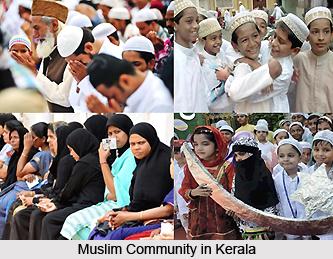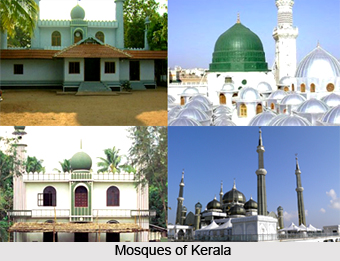Muslims of Kerala form two major groups; the descendants of the Arab merchants who have been trading along the Malabar Coast since before the beginning of recorded history, and the Malayalis who were converted either forcibly during the rule of Hyder Ali and Tipu Sultan in the late 18th century voluntarily because they wished to escape from the disabilities of belonging to low Hindu castes. The descendants of the Arabs claim that they brought Islam to Kerala before the end of the 7th century, and that their religion made its way peacefully along the Malabar Coast long before the Afghans propagated it by sword in northern India. The Muslims have remained strongest in Malabar, the northern part of Kerala; around Calicut (Kozhikode) they comprise almost half the population. Only a tiny minority of the Muslims of Kerala are of Arab descent.
Arrival of Islam in Kerala
Islam came to Kerala long before it reached other parts of India, and it came peacefully, carried by the sails of trading ships. The arrival of Islam, like that of Christianity, is not recorded, and here again tradition takes the place of history.
 But, since traders from Arabia were sailing to the Malabar Coast throughout the period when Mohammed was doing the great conversions, one can assume that Muslims were living there as merchants no later than the mid-seventh century. Like the Christians and Jews of Kerala, the Muslims believe Cranganore or Kodungallur to have been the first place where their religion began.
But, since traders from Arabia were sailing to the Malabar Coast throughout the period when Mohammed was doing the great conversions, one can assume that Muslims were living there as merchants no later than the mid-seventh century. Like the Christians and Jews of Kerala, the Muslims believe Cranganore or Kodungallur to have been the first place where their religion began.
Conversion to Islam in Kerala
Many of the Arabs frequenting the Malabar Coast took native women as wives or concubines, and the offspring of these unions were among the first Moplahs or Mapillas, as the native Muslims are called. The actual conversions were mainly among the lower castes. During the second Chera Empire, Muslims resided in every part of Kerala from Kannur to Kollam. The coins of 8th century Omayyad Caliphs have been found even in inland towns such as the old Christian centre of Kothamangalam. The 9th and 19th centuries Arab chroniclers like Ibn Khur-dadbeh and Ibn Hankal spoke of the great trade of the cities of Malabar, and of the mosques where the merchants offered prayer. Relations between Hindus and Muslims in Kozhikode (Calicut) were marked by an extraordinary mutual trust. The Muslims of Malabar lived in great comfort and tranquillity in consequence of their abstaining from exercising any oppression as well as from the consideration which they invariably evinced for the ancient usages of Malabar. Though the Muslims attempted no political domination of the principalities with which they traded, showing in this way a marked difference from the Portuguese traders who followed them, they still played a political role.
Similar to the Christians, though in different ways, the Muslims were to suffer greatly from the arrival of the Portuguese in Kerala. Further, much of the violence that mars the history of Kerala in the 16th and 17th centuries is attributable to the irreconcilable hatred between the Catholics from the Iberian peninsula and the Moors, as the  Portuguese insisted on calling their rivals, identifying these Arabian traders with the enemies whom they had fought so long and bitterly to liberate their own land. In their turn, the Muslims resisted the Portuguese passionately, since their lives as well as their livings were at stake, and they encouraged the Malayali people also to resist; so that the presence of adherents of Islam on the Malabar Coast was to have an influence on the region`s history far out of proportion to their numbers.
Portuguese insisted on calling their rivals, identifying these Arabian traders with the enemies whom they had fought so long and bitterly to liberate their own land. In their turn, the Muslims resisted the Portuguese passionately, since their lives as well as their livings were at stake, and they encouraged the Malayali people also to resist; so that the presence of adherents of Islam on the Malabar Coast was to have an influence on the region`s history far out of proportion to their numbers.
During this period the Muslims did not form a large proportion of the population of Kerala, as they do today. They lived only on the coast, in the towns where some kind of maritime trade was carried on, and, even for the purposes of trade, they do not appear to have penetrated far inland. The large-scale conversion of the farming population in the Keralan interior belonged to a later period. According to their own historians, even in Calicut they amounted to less than a tenth of the population, and among those the number of Malayali Muslims was relatively small. Yet almost all the foreign trade was in their hands. Avoiding the temptation to follow the example of the North Indian Muslims by making themselves kings, they had succeeded in becoming the merchant princes of the Malabar Coast.



















